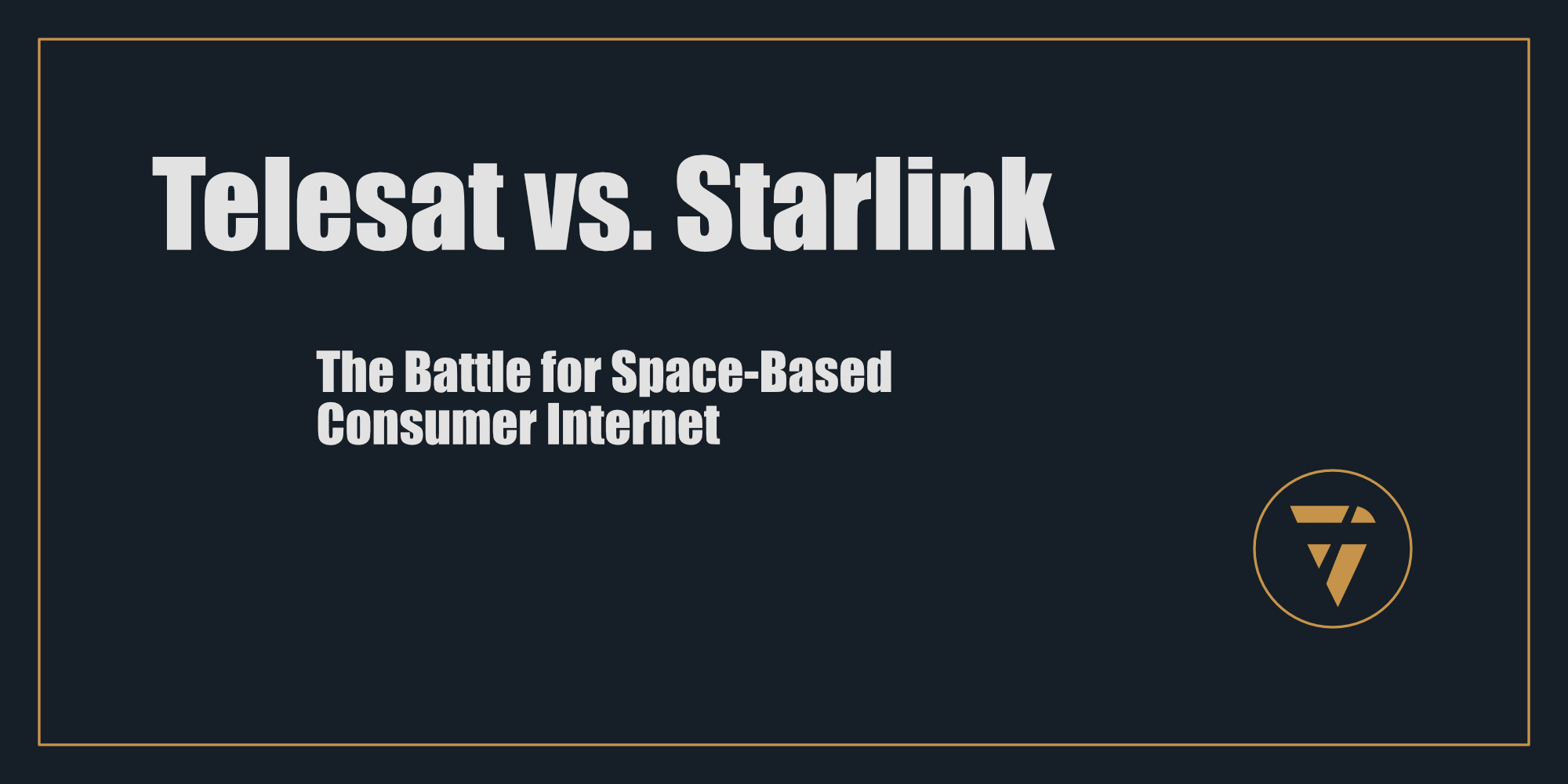Telesat vs. Starlink

The Battle for Space-Based Consumer Internet
For decades, Telesat has been a silent giant in the satellite communications industry, operating some of the most sophisticated geostationary satellites for enterprise and government clients. Yet, as SpaceX’s Starlink disrupts the global broadband market with an aggressive low-earth orbit (LEO) strategy, Telesat finds itself at a crossroads: Will Lightspeed remain an enterprise-focused network, or can it evolve into a true Starlink competitor, bringing high-speed internet to consumers worldwide?
The answer is not simple. While Telesat’s Lightspeed constellation is engineered for ultra-high reliability and enterprise-grade connectivity, the consumer market is an entirely different beast—one that demands affordability, seamless service, and mass-scale adoption. To compete head-to-head with Starlink, Telesat must fundamentally shift its business model, scale its operations, and rethink its approach to satellite broadband.
This is the blueprint for how Telesat can move from a niche player to a mass-market disruptor.
The Starlink Phenomenon: A Benchmark for Consumer Space Internet
Before dissecting Telesat’s pathway to mass adoption, it’s crucial to understand why Starlink has been so successful.
SpaceX has rewritten the rules of satellite internet, deploying a massive constellation of over 5,000 LEO satellites at an unprecedented rate. The key to Starlink’s success lies in four fundamental advantages:
- Scale and Speed – SpaceX’s ability to launch multiple satellites per Falcon 9 mission (often over 50 per launch) allows for rapid expansion, ensuring global coverage at speeds exceeding 250 Mbps.
- Vertically Integrated Supply Chain – SpaceX controls both the satellite production and launch capabilities, drastically reducing costs and accelerating deployment.
- Consumer-Friendly Business Model – Unlike legacy satellite providers with high installation fees and complex contracts, Starlink offers a straightforward, flat-rate subscription model with plug-and-play hardware.
- Regulatory Agility – Starlink aggressively secures spectrum rights and operating licenses in every major market, bypassing red tape that often slows traditional telecom providers.
With these competitive advantages, Starlink has already attracted over 2.3 million subscribers worldwide—a number that continues to grow.
For Telesat to enter this arena, it must not only match Starlink’s offerings but differentiate itself in a way that appeals to both consumers and businesses alike.
The Lightspeed Edge: Where Telesat Can Win
Telesat’s Lightspeed network was never designed for the mass consumer market. It was engineered to provide enterprise-grade connectivity for industries such as aviation, maritime, military, and remote operations. This means its architecture is fundamentally different from Starlink in several ways:
- Enterprise-First Infrastructure – Lightspeed prioritizes low-latency, high-redundancy connectivity with carrier-grade reliability, making it ideal for mission-critical applications.
- Advanced Optical Networking – Lightspeed utilizes laser inter-satellite links (ISLs) to deliver seamless global coverage without relying as heavily on ground stations.
- Premium Bandwidth Management – Telesat has designed Lightspeed to optimize data throughput for large-scale users, such as government agencies, instead of distributing bandwidth across millions of residential customers.
These features make Lightspeed a superior network for business and government applications, but adapting it for consumers would require significant changes.
From Enterprise to Consumer: The Roadmap for Telesat’s Mass Market Expansion
For Lightspeed to become a viable alternative to Starlink in the consumer market, Telesat must undergo a multi-stage transformation.
1. Consumer-Centric Business Model
Historically, Telesat has relied on B2B partnerships rather than direct consumer sales. Competing with Starlink would require a major shift toward a direct-to-consumer (DTC) model, similar to what SpaceX has achieved.
- Subscription-Based Pricing – Consumers expect a simple, monthly subscription model rather than complex contracts. A competitive price point would likely need to be $100–$150 per month, aligning with Starlink’s offerings.
- Retail Distribution Strategy – Telesat could leverage partnerships with major telecom providers (e.g., Bell, Rogers, Verizon) to bundle Lightspeed into hybrid satellite + 5G internet packages.
- Scalable Support Infrastructure – Unlike enterprise clients who receive dedicated account managers, consumer users need 24/7 customer support, troubleshooting guides, and an intuitive mobile app.
Telesat would need to build this infrastructure from scratch, or partner with an established ISP to handle distribution and customer service.
2. Hardware: Affordable, Plug-and-Play User Terminals
One of the most significant barriers to consumer adoption is hardware cost and accessibility. Starlink’s Dishy McFlatface antenna is a marvel of consumer engineering, offering easy setup and relatively low costs ($599 upfront).
Telesat’s Lightspeed network, however, currently requires enterprise-class terminals that are far too expensive and complex for average users. To scale in the consumer market, Telesat must:
- Develop a cost-effective user terminal priced under $500.
- Ensure plug-and-play installation with minimal setup requirements.
- Leverage mass production by partnering with hardware manufacturers like Foxconn or Flex to lower unit costs.
Without these changes, Lightspeed will remain inaccessible to mainstream consumers.
3. Scaling the Constellation: More Satellites, Faster Deployment
Starlink operates at a scale unmatched by any competitor, with thousands of satellites already in orbit. In contrast, Lightspeed is currently designed to launch 198 satellites—a fraction of what’s needed for comprehensive consumer coverage.
For Telesat to compete, it must:
- Increase its constellation size to at least 1,000+ satellites for robust coverage.
- Accelerate launch timelines by securing additional partnerships beyond SpaceX’s Falcon 9 contract (e.g., Blue Origin’s New Glenn, Relativity Space’s Terran R).
- Expand ground station infrastructure to match Starlink’s ability to provide low-latency global coverage.
This would require billions in additional investment but is non-negotiable for competing in the consumer market.
4. Strategic Differentiation: Where Telesat Can Outshine Starlink
Telesat must acknowledge that it cannot outcompete Starlink purely on scale. Instead, it must offer unique value propositions that appeal to specific consumer segments:
- Enterprise-Grade Reliability for Consumers – Positioning Lightspeed as the premium choice for users who demand higher reliability than Starlink (e.g., businesses, rural professionals, high-end travelers).
- Hybrid 5G + Satellite Bundles – Unlike Starlink, which operates independently, Telesat could partner with telecom carriers to integrate Lightspeed into 5G rural expansion projects.
- Regulatory Stability – With strong government backing, Telesat could secure exclusive spectrum rights and long-term contracts that Starlink, as an independent disruptor, struggles to obtain.
The Future of Consumer Satellite Internet: A Two-Horse Race?
If Telesat executes this strategy effectively, it could become the primary alternative to Starlink in the global consumer broadband market. While Starlink enjoys an early-mover advantage, Lightspeed could carve out a profitable niche as a high-performance, enterprise-grade alternative with enhanced regulatory backing and telecom partnerships.
The question remains: Does Telesat have the ambition and capital to pivot toward consumers, or will it remain an enterprise-only solution?
The answer will determine whether Starlink continues its dominance—or if Telesat can disrupt the disruptor.
Oh, and Telesat isn't run by Bond villain Nazis trying to destabilize the function of global society.
This is what I’m working on. Tell me what you think, I enjoy the conversation! Subscribe and follow the work in real time.
Thanks!
B

Telesat’s Lightspeed has the tech, but not the scale. To compete with Starlink, it needs a consumer pivot. Plug-and-play terminals, mass launches, and a DTC model. Will they disrupt the disruptor, or stay enterprise-only?
PS -






